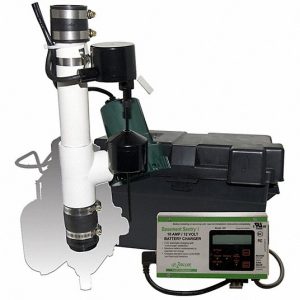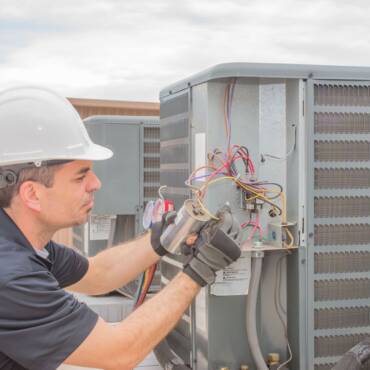Water damage is a massive problem for homeowners in America, with the number of Americans facing emergency related water damage reaching 14,000 yearly.
The annual cost of water damage and removal in the United States is $13 billion. Thankfully, there’s something you can do to protect yourself and your home from such severe water damage.
Issues with your plumbing and appliances are the most common reasons for water damage in a home, and most homeowner’s insurance doesn’t cover flooding in the basement.
That’s why installing a sump pump in your home—with all its pros and cons— can help save you a lot of headache and money in the long run.
Let’s explore the pros and cons of sump pumps to help you determine if they’re right for you and your home.
What is a Sump Pump?
To fully understand sump pump advantages and disadvantages, it helps to understand what a sump pump is and how it operates.
A sump pump is a plumbing device meant to be installed at the lowest point of the home, typically a basement—or a crawl space if there is no basement.
While sump pumps are submersible, they are on standby most of the time, waiting to keep water from flooding your home when it’s necessary.
Heavy rains, a clogged drain, or even excessive snowmelt can all end up flooding your home and causing water damage.
A sump pump is designed to keep that flooding down, keep water away, and keep your home protected. They do this with their fairly straightforward operation.
As rain or excessive snowmelt over-saturates the soil around your home, the groundwater collects and funnels toward the sump pit where your sump pump is installed.
This causes the sump pit to begin filling with water. As the waters rise, the float switch on your sump pump activates the sump pump, which starts diverting water away from your home and lowering the water levels.
This entire process keeps water from rising in your basement and prevents flood damage to your home.
Let’s dive into sump pump pros and cons.
Pros
As you consider the pros and cons, keep in mind that getting a quality sump pump is dependent on you working with a quality plumber.
A bad installation job or an improperly skilled technician can make even the best advantages of a sump pump pointless. Always work with the professionals.
Now let’s explore sump pump pros and cons, starting with the pros.
Removes Flood Water from Basement
One of the most obvious advantages of sump pumps is that they remove excess water that gets into your basement. This means that if your basement ever ends up flooded, or if you live in an area with frequent flooding or heavy rains, your basement is better protected.

Sump pumps are capable of draining a flooded basement and pumping away water from the earth beneath your home to prevent flooding from happening in the first place.
Performs Better than Waterproofing.
While external waterproofing can help your home, it doesn’t do nearly as good of a job of protecting your home from flooding as a sump pump does.
Waterproof coatings often crack, weaken over time, or just fail to work properly and can lead to your home flooding without a way to get the water out. A sump pump keeps you prepared and protected in these situations.
A Water Powered Sump Pump Always has Power
A water powered sump pump’s pros and cons are slightly different from an electric sump pump. If you get an electric sump pump, obviously it will need a power source to operate properly, but a water powered sump pump always has power and keeps the same pumping rates (though it does require municipal water).
Sump Pumps are an Active System
This means that sump pumps work actively to prevent water from getting into your home and pump water out if it does get in.
They are constantly working to keep water away from your home before it makes its way through any cracks. Basement drains or even external waterproof coatings are passive systems in that they are simply present to whatever ends up happening.
Cons
Now let’s consider some cons to sump pumps.
Sump Pumps Require Electricity
Unless you have a water powered sump pump, your sump pump needs electricity when it turns on.
This can be a problem if a severe rainstorm has caused a power outage, since you could end up with a flooded basement. Making sure that your sump pump has a battery backup that is sealed against water damage is the best approach to resolving this con.
Requires a Pit
To install a sump pump, you need a sump pump pit. This process creates an opening in the earth under your home, which not only is a substantial task, but it creates a Radon risk.

Any whole in your foundation creates a risk for Radon getting into your home, but a sump pump pit is substantial.
Unsightly Appearance
Many homeowners find the sight of a sump pump unattractive. The installation process leaves an exposed hole in your foundation, which many homeowners don’t feel great about.
If you need a neat, tidy basement appearance, then a sump pump may not be your best option.
As you consider the sump pump pros and cons, it’s important to also consider the cost of the job. While sump pumps aren’t overly expensive and the installation cost is manageable, the overall cost that goes into waterproofing your home can add up.
Many homes have more than one type of waterproofing, so be sure you consider all your options alongside your budget as you make your decision.
When Should I Install a Sump Pump?
The best time to install a sump pump depends entirely on your local weather.
Fall is a great time to install a sump pump in many northern states, so it can be done before the winter sets in and the ground freezes. In areas that deal with a lot of rain, especially southern states, it’s important to install your sump pump before the heavy rain season sets in.
Consider any past weather or water issues you’ve had in your home. If you’ve dealt with basement flooding during the rainy season before, you absolutely want to get a sump pump installed before the rain comes again.
If you’re not sure what the water history is with your home, then consider the location of your home. Groundwater is more likely to rise up under your basement if your home has poorly draining soil, is on a flat plot with bad drainage, or is on a low-lying plot below a water table.
If you have a finished basement or want to protect any storage in your basement, it’s also a good idea to get a sump pump.
Protect Your Basement
If your current sump pump is malfunctioning or if you are looking to install a new one, trust John C. Flood for the job.
You can schedule a service with us online or call our expert team to get all your questions answered.
Don’t wait for a big rainstorm or a flooded basement to get your sump pump working. Schedule your sump pump service today.
Whether you require installation, repair, or maintenance, our technicians will assist you with top-quality service at any time of the day or night. Take comfort in knowing your indoor air quality is the best it can be with MOE heating & cooling services Ontario's solution for heating, air conditioning, and ventilation that’s cooler than the rest.
Contact us to schedule a visit. Our qualified team of technicians, are always ready to help you and guide you for heating and cooling issues. Weather you want to replace an old furnace or install a brand new air conditioner, we are here to help you. Our main office is at Kitchener but we can service most of Ontario's cities
Source link



Add Comment